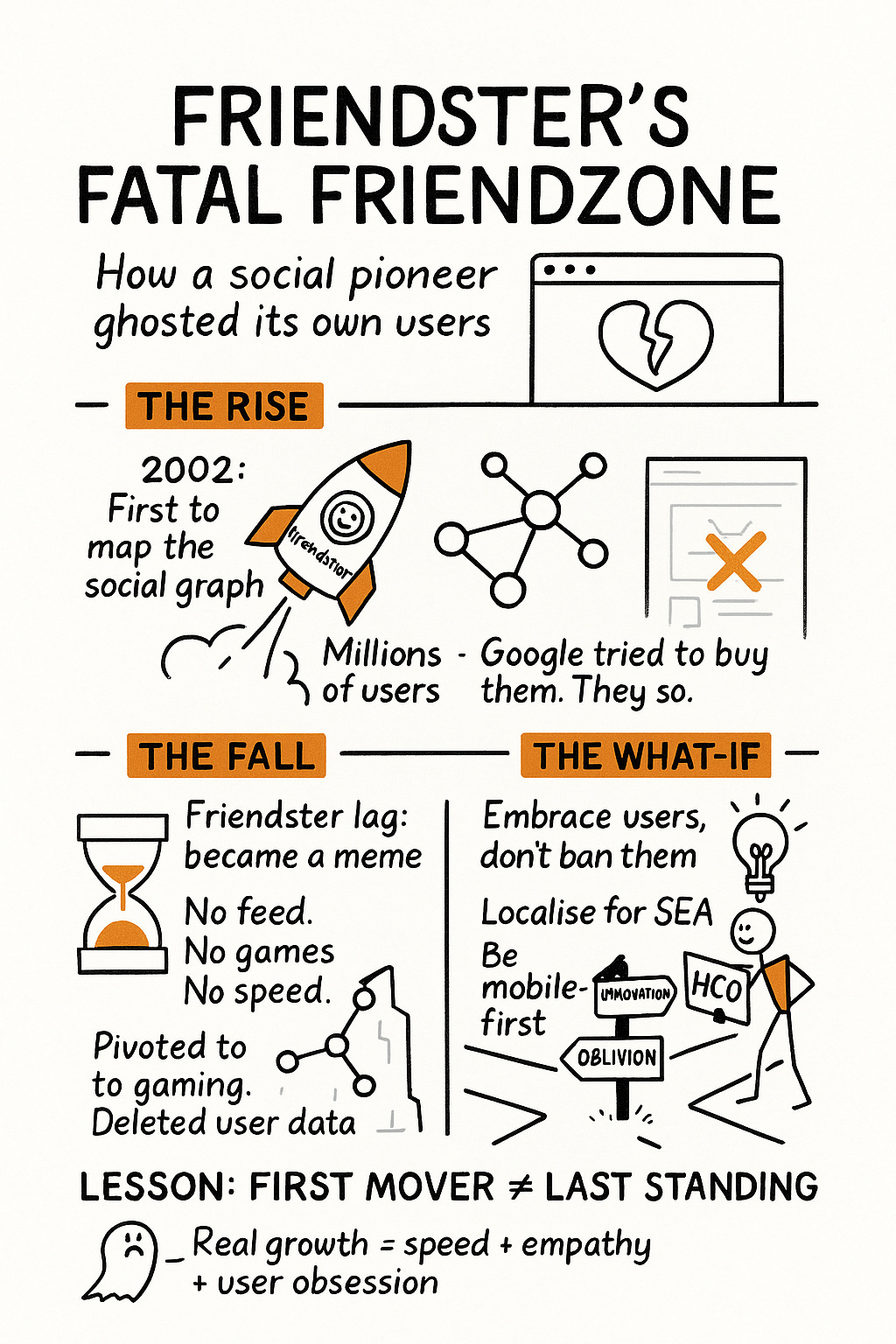Friendster’s Fatal Friendzone: How a Social Pioneer Ghosted Its Own Users
Discover the rise and fall of Friendster — the original social network that pioneered online connections but failed to evolve. A cautionary tale in growth, product, and human-centered design.
This week in BCG’s Digital Transformation course, we explored the power of digital networking, where the modern handshake is now your LinkedIn profile. From profile pictures to personal brand statements, one idea stood out: your profile page is your homepage.
Naturally, my brain time-travelled. Straight back to Friendster.
Yes, that Friendster (and yes, definitely revealing my age here). 18-year-old me spent an unhealthy amount of time curating the perfect profile pic, crafting witty testimonials with friends, and refreshing obsessively to see who viewed my page. Back then, that was peak social currency.
But Friendster wasn’t just a nostalgic relic of the early 2000s. It was a product pioneer.
The first platform to map out the social graph, the first to scale real-world friendships into digital networks… and, tragically, the first to ghost its users when it mattered most.
In this teardown, we unpack the rise and fall of this forgotten giant:
What Friendster got right before everyone else,
Where it unravelled under the weight of its own promise, and
How a human-centered design (HCD) mindset might have rewritten its fate.
Let’s dive into one of tech’s greatest “what ifs.”
1. The Rise: A Social Graph Before Its Time
In 2002, Jonathan Abrams launched a bold new idea: what if you could map your real-world friendships online and meet friends-of-friends through a clean, safe, and engaging interface?
The world said yes, and Friendster exploded.
By 2003, it had millions of users, glowing media buzz, and a cult-like following. It was called “the next Google”, a compliment that aged like unrefrigerated sushi.
Legend has it, even Google tried to buy Friendster for tens of millions. Friendster said no. Spoiler: That decision didn't age well either.
But let’s give credit where it’s due. Friendster nailed early UX:
Clean, personal profiles before clutter was cool.
The addictive “Who viewed your profile” feature, a dopamine loop LinkedIn now cashes in on.
Testimonials from friends that served as early social proof (and humblebrag opportunities).
And most importantly, the social graph: a visual way to see how you’re connected to others through mutual friends. Back then? That was digital sorcery.
2. The Tipping Point: When Things Got... Weird
And then came the Fakesters.
Profiles for Batman. Nietzsche. Chocolate Cake. It was weird, wonderful, and viral before viral was a thing. But Friendster didn’t get the joke. Instead of leaning into the creativity, they deleted the fake profiles, and with them, their most passionate users.
Meanwhile, the U.S. user base started ghosting.
MySpace wooed them with messy, expressive chaos. Facebook seduced them with College-exclusivity and polished design. Friendster stood still, watching the party move elsewhere.
By the late 2000s, a plot twist: 90% of Friendster’s traffic came from Southeast Asia.
They had an audience, just not the one they planned for.
3. Missed Opportunities: The Trifecta of Failure
TECH – The Lag That Killed Loyalty
The site was famously slow. Like, "go-make-a-coffee" slow.
Built on Java, Friendster couldn't scale with its social graph and became the punchline of its own meme: Friendster lag. Meanwhile, Facebook built fast, scaled smart, and never let UX suffer under growth.
PRODUCT – No Feed, No Fun
Friendster stuck to static profiles while Facebook launched News Feed.
It didn’t enable third-party developers, while Facebook unleashed FarmVille and viral app madness. Still remember our good friend, Zynga?
It had the graph but not the engine.
Result? Friendster felt frozen in time while Facebook evolved daily.
BUSINESS – Strategy by Panic
Friendster went through more leadership changes than a reality TV show.
No one knew if it was a dating site, a networking tool, or a social game.
In 2011, in a last-ditch move, they deleted all user data and relaunched as a gaming platform.
Imagine rage-quitting your product but at enterprise scale.
4. What If? The HCD Alternate Timeline
Let’s imagine a different path. One where Human-Centered Design (HCD) wasn’t an afterthought, but a guiding principle.
Embrace the Fakesters
Instead of purging Batman and Chocolate Cake, create Pages or Communities.
Let creativity flourish. Imagine Friendster becoming Reddit meets Facebook Pages before either existed.
Localise, Don’t Generalise
Asia loved Friendster. The company could’ve returned the love with:
Mobile-friendly UX for low-bandwidth regions.
Regional games and pop culture features.
SMS integration for the pre-smartphone crowd.
Mobile-First Before It Was Trendy
SEA users were leapfrogging desktops straight to smartphones.
Friendster could’ve become the first mobile-native social platform. optimised for Asia, built for the future, and one step ahead of Facebook.
Final Thoughts: From First Mover to Forgotten
Friendster’s story isn’t just tech nostalgia for millennials with dial-up memories; it’s a cautionary tale etched into the playbook of product history.
Yes, it was first. Yes, it was innovative. But as every growth and product leader knows, being first to market doesn’t guarantee you’ll last. (In fact, sometimes it just means you're the first to make all the mistakes.)
Here’s what Friendster teaches us:
Being early isn’t enough. Execution always trumps invention.
Features don’t matter if your platform collapses under its own weight.
User signals are everything. Ignore them, and they’ll ignore you back.
Friendster had the vision, the users, and the momentum. But it lost the plot when it stopped evolving with its community and started playing defence.
In today’s world, obsessed with growth hacks, retention tricks, and flashy metrics, Friendster reminds us of a deeper truth:
👉 Real growth isn’t about being viral. It’s about being valuable.
👉 It’s built on speed, empathy, and relentless relevance.
The next time you’re shipping a feature, scaling a platform, or debating a pivot, remember Friendster. The social network that had everything… except the humility to listen and the agility to change.

